#what if. i abandon my life. to study the guitar and become a folk musician
Explore tagged Tumblr posts
Text
it’s a pincushion with the pins stuck in the wrong way
#what if. i abandon my life. to study the guitar and become a folk musician#and then abandon that too because the guitar will give me Rsi#*RSIs like you can’t even imagine#box opener#what could matter compared to the vital importance of which tradition introduced ending the song with the name of the town#or why it was conflated with a lancastrian song#ok i mean tudor but the tudors kept doing shit. tudor in their lancastrian capacity
7 notes
·
View notes
Text
https://thelast-magazine.com/tlm13-johnny-flynn/




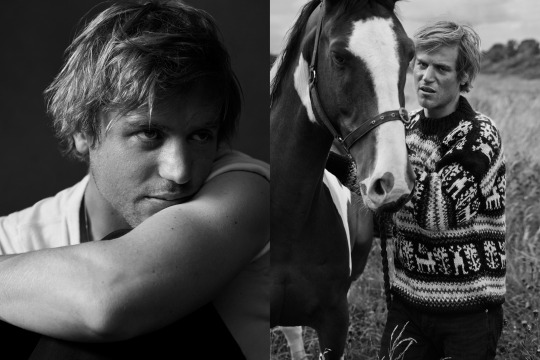
JANUARY 22, 2015 ACTORCULTUREFILMMUSIC
TLM13: JOHNNY FLYNN
A resonator is a type of guitar built for a sound many generations old. It hums and shines, as if an acoustic guitar was broadcast through a tinny phone line. Rather than a wood sounding board, the heart of the guitar is a metal cone, ornately decorated, that brittles the sound and projects it even without electronic amplification. Resonators are rarer now; they’re hard to come by. But they carry a unique magic in their sound, their history, and their owners.
It was one of the first things he purchased with his record-deal money, and it has followed Flynn’s eclectic artistic path as band leader of the Sussex Wit and now as an actor, where he strums and plucks it through Song One, a film about a folk musician searching for inspiration and finding it in a woman and the New York music scene she traverses.
“I’ve learned that when a creative path dies out, another door opens, and you have to stay loose enough, present enough, and absorbent enough to figure out what path you have to walk down,” Flynn says in his soft English accent. “That sounds like a terrible cliché, but being in creative industries, for me, is a spiritual path.”
Flynn has been carving that path, guitar in tow, with a balance of wide-eyed enthusiasm and artistic curiosity. He has sought out company that emphasizes shared forms of creativity, whether onstage, on camera, or in the pubs and music nights of London’s early-Aughts folk scene.
Flynn is in London now helping produce English singer-songwriter Nick Mulvey’s album. We speak after a studio session with Flynn in a cab back to his London flat just after sunset, a small break from a schedule that has permitted him more time to his songwriting and the musical community that gave him so much of his identity. Flynn never left music, but he felt the need to slow down to give acting his full focus. “I hate having to rush a job because you need the space to say what you have to say with your fullest voice and as much confidence as possible,” Flynn says.
“Not being honest in those circumstances is my version of being sacrilegious or blasphemous. There’re lots of ways of doing something, but if you find a way that’s true, then you’re happy.
Several years ago, Flynn stopped touring in order to pursue a series of increasingly meaty acting roles, including a run at Shakespeare’s Globe Theatre in the acclaimed, all-male Shakespearean troupe Propeller. Now Flynn’s about to have even less time, thanks to a breakout role in Song One, opposite Anne Hathaway, and the upcoming Olivier Assayas film, Clouds of Sils Maria, opposite Juliette Binoche, Kristen Stewart, and Chloë Grace Moretz.
In some ways, it has improved his songwriting. “I’m never going to abandon music,” Flynn says. “I was dragged back out to play shows here, and it was a good thing to be reminded that this is something I love doing.” Flynn’s friends did everything they could to “drag” him out for some gigs. It helps when your friends happen to be Mumford & Sons, who actually played one of their first performances opening for Flynn. “So many bands only get to write songs about the view from their hotel window, but I get to work with language and be inspired by that,” Flynn continues. “That seems invaluable as a song- writer. I am very grateful for that.”
To hear Flynn sing is not to see him. His solid build, tousled hair, and craggy features absolutely do not set you up for the lilting way his lyrics seem to fall and float out of him. His voice can crackle or rise sweetly into a falsetto, all while singing stories of small towns, large hopes, and even larger characters.
There seems to be a minor groundswell of British folk musicians waiting for Flynn to finish with all this acting business and get back to music full-time. But Flynn embodies a new creative state of mind, one that is not bordered by form— musician, actor, painter, poet—but one that applies considerable talents to tell better stories.
The story of Song One hews close to Flynn’s own. James Forester is a folk guitarist, resonator in hand, searching for inspiration. Forester, like Flynn, is exceedingly polite, a dewy-eyed talent capable of heart-grabbing honesty both onstage and off. “In terms of lifestyle and where his head is at, a lot of that stuff came from conversations with Kate [Barker-Froyland], the director, of what it was like to be a musician out on the road,” Flynn says. “I think he’s a character that is quite close to me, so I have to find a fine line. In real life, I’ve got a wife and a kid.”
Song One’s music went through a similar process; written for—but not by—Flynn, he used the songs as a way to find his character. “That’s what being an actor is about,” Flynn says. “You’re doing a good job if you’re serving the piece. It was quite a relief in a way to not have to worry about every aspect of the music. I think I enjoy giving up that leadership role for those situations.” The collaboration between Flynn and songwriters Jenny Flynn, Johnathan Rice, and Nate Walcott resulted in an album, which they recorded on weekends between shoots. Even though the songs are not Flynn’s, it’s hard to imagine anyone taking them from him. There is a stamp Flynn places on his projects, a vibration that is all his own.
In a way, Song One best captures the hell and catharsis of creativity. “You sometimes lose your way or you end up turning out the same stuff for a while, and before you know it you end up losing your inspiration, what put you there in the first place,” Flynn says. “And then you find it.”
What put Flynn there in the first place was an old book of hand-written folk songs and The Freewheeling Bob Dylan. Born in Johannesburg, Flynn moved with his family to Hampshire, England, when he was three. He earned a music scholarship, picking up violin and trumpet, but classes felt forced and dull.
“I learned to play the guitar using an old songbook of my mum’s that she’d handwritten, and it was full of traditional folk songs, songs that she loved,” Flynn recalls. “I got really obsessed with the Bob Dylan songs because they were really exciting to me. I was studying music as a music scholar, but I was listening to all of that stuff.”
Folk music has a tendency to take care of its own, and Flynn found himself mingling with the artists who would come to define the modern folk sound in its early London years. He and some friends established a music night, called Apocalypso, with fellow folk musicians Emmy the Great and Tom Hatred. “We played with people like Laura Marling when she was starting out, and Florence from Florence and the Machine when she was around,” Flynn says. “It was an early scene to be a part of in London at that time when I was forming my musical identity. When I was growing up, we didn’t have much money, but it was about finding something to do together.”
If Flynn found a musical family in Apocalypso, it was a mirror of his own upbringing. “My dad was writing songs in the Sixties and Seventies, and my mum sang songs and had been a folk singer in the Seventies,” Flynn says. “My older brothers are actors and keen on music. Yes, I guess, I loved hanging around backstage when my dad was doing shows. That atmosphere was what really infected me and made me want to become an actor. It seemed like this magical world of storytelling that my family was privileged to be involved in. Because I went away to boarding school, and I was studying classical music, my way of rebelling was to write my own music. I just fell in with a group of friends who liked to make music and were obsessed with studying the history as well, both American and British. Those are our heroes. It kind of took me over.
It was Emmy who initially introduced Flynn to resonator guitars. She had an old metal resonator lying around and Flynn took to it. “At one point I was crashing on her sofa and I was using her guitar a lot,” Flynn says. “I used it for a lot of bedroom recordings and things, and I fell in love with it.”
That guitar, with its odd metal heart, helped Flynn find his voice, a voice he is now rediscovering in film. “I think playing characters onstage and things like that has told me that you can take on various entities and channel your own voice through the habits of a certain character, the rhythm of someone else’s voice or using someone else’s language,” Flynn says. “But you still have to have your own heart in the middle of it.”
Song One is out January 23. Clouds of Sils Maria is out April 10.
Zachary Sniderman is the associate editor of The Last Magazine.
Styling by Celestine Cooney. Hair by Lee Machin at Caren. Grooming by Jenny Coombs at Streeters. Photographer’s assistants: Iain Anderson and Alec McLeish. Stylist’s assistant: Poppie Clinch. Digital technician: Mike Harris. Production by Lucie Mamont.
By
Zachary Sniderman
Photography by
Ben Weller
2 notes
·
View notes
Text
Favourite music of the decade!
This is some of what I’d consider the most innovative, artistic and just great to listen to music from 2010-2019.
First a Lot of very good songs:
Crying - Premonitory dream
Arcade Fire - Normal person
Sufjan Stevens - I want to be well
Deerhunter - Sailing
Foster the People - Pumped up kicks
Carly Rae Jepsen - Boy problems
Grimes - Butterfly
Travis Scott - Butterfly effect
Future - March madness
Kanye West ft. Nicki Minaj et al - Monster
Juice Wrld - Won’t let go
Danny Brown - Downward spiral
Kendrick Lamar - Sing about me, I’m dying of thirst
Kate Tempest - Marshall Law
The Avalanches - Stepkids
Iglooghost - Bug thief
Vektroid - Yr heart
Ariel Pink - Little wig
Mac Demarco - Sherrill
Vektor - Charging the void
Jyocho - 太陽と暮らしてきた [family]
Panic! at the disco - Ready to go
The Wonder Years - An American religion
Oso oso - Wake up next to god
The World Is a Beautiful Place & I Am No Longer Afraid to Die - I can be afraid of anything
And my top 20(+2) albums:

Calling Rich gang’s style influential on trap would be like saying Nirvana may have had some impact on early-90s grunge. In 2019 with trap so omnipresent in popular music, hip hop or otherwise, through the impact of artists like Drake and Travis Scott it’s almost hard to remember when this was a niche genre - it was Rich gang that popularised its modern sound here. Birdman’s beats with their rattling hi-hats and deep bass could have been made 5 years later without arousing suspicion, while Rich Homie Quan and Young Thug deliver consistently entertaining flows and numerous bangers between them. Thugger, this being his first major project, steals the show with his yelpy and hilarious rapping style. This may have once been the defining sound of house parties in the Atlanta projects; now it can be heard blasting in the night from white people’s sound systems around the world.
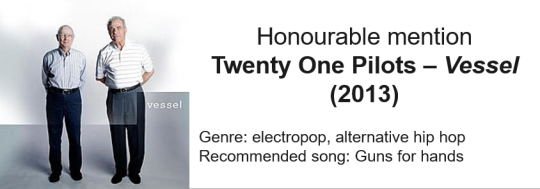
Early 21p may have never aimed to be cool, to avoid a certain appearance of lameness, but they did have a knack for writing some really catchy pop with an optimistic message. To the devoted, the critics of Pilots’ apparent mishmash of nerdy rap, sentimental piano balladry and EDM production were just stuffy, wanting music to stay how it was back-in-the-day forever and unwilling to get with the times. This viewpoint is understandable when you approach this album openly and actually listen to Tyler Joseph’s lyrics about youthful anxiety and insecurity, delivered with real conviction and sincerity, actually recognise that disparate musical elements are all there for emotional punch. A few songs do underwhelm. But this is emo for post-emo Gen Z’s and it’s easy to see why to some it can be deeply affecting.

The musical ancestor to the ongoing and endless stream of ‘lo-fi hip hop beats’ youtube mixes, chillwave filled the same low-stress niche, and Dive released at the peak of the genre’s relevance. Tycho’s woozy, mellow sound prominently features rich acoustic and bass guitar melodies over warm synths, enhancing the music’s organic feel compared to that of purely digital producers in the genre. The experience of starting this album is like waking up in a soft bed, the cover’s gorgeous sunrise reddening the room’s walls, while a guitarist improvises somewhere on the Mediterranean streets outside. And it is indeed great to study or relax to!

Simple, minimal acoustic guitar and vocals. If you’ve got talent this type of music shows it, or else it doesn’t: perfect then for Ichiko Aoba. Her touch is light, her songs calm, meditative, in no rush to get anywhere. As if serenely watching a natural landscape, one can best understand and enjoy Aoba’s music in quiet and peaceful appreciation.
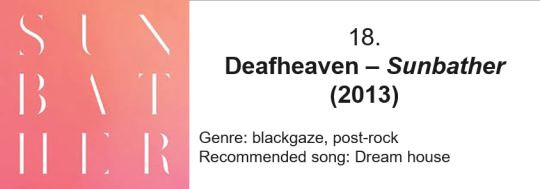
Through the incorporation of genres like shoegaze and alternative rock, Deafheaven managed to create a rare thing: a metal album that’s both heavy and accessible, needing no sacrifice of one for the other’s sake. Over these four main songs, there’s a sensation of being taken on an intense, atmospheric and even emotional journey, with the band stepping away from the negativity and misanthropy that dominates most metal. The vocals, closer to the confessionalism of screamo than classic black metal shrieks, express more sadness than they do aggression, and in respites between solid blaring walls of guitar and drums, calm pianos and gently strummed guitar passages set a pensive tone. This totally enveloping, flawlessly produced sound can take you away, like My Bloody Valentine’s best work, into a dream or trance.

By the late 2000s MCR had taken their thrones as the kings of a subculture formed from the coalition of goth, emo, scene and other assorted Hot Topic-donned kids, and earned a lifelong place in the hearts of many a depressed teenager. But after the generation-defining The Black Parade Gerard Way took off the white facepaint and skeleton costume, ditched the lyrics about corpse brides and vampires, and embraced an anthemic, purely pop punk sound. The silly story of Danger Days, set in a dystopian California where villainous corporations rule and only the Punks can stop them, serves as a kind of idealised setting for the all-out rebellion against authority and normality that so many fantasised about taking part in. The band’s electrifying performances are the most uplifting of their decade making music. For many diehards the upbeat sound here was a celebration that they’d made it through the most difficult years of their lives, and a spit in the face of those who’d done them wrong.
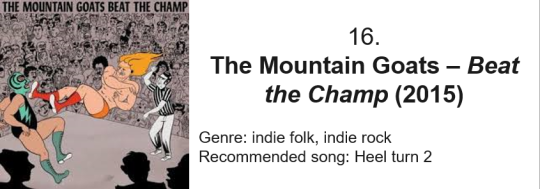
The teller of rural American tales, the indie legend, the teen-whisperer himself. John Darnielle, long past his early lo-fidelity home recordings and now backed by a full band, loses none of the heart his songs are famous for. The theme of the album, taken straight from John’s childhood when the pro wrestling on TV offered an escape from his abusive stepfather, is complemented by the country and Tex-Mex flavouring to the instrumentation. Some of the best lyrics in his long career infuse the stories of wrestlers with universal meaning - his characters try, fail, lose hope, reckon with their mediocrity, and when they step into the ring they’re up against all the adversity life can throw at them. John Darnielle’s saying that when that happens, you stand up and sock back.

Folk music was always a major part of the Scandinavian black metal scene during its peak years, so when American musicians began exploring the genre naturally they incorporated American styles of folk. The complex, oppressive and sometimes hellish compositions here, starkly contrasted with bluegrass that sounds straight from the campfire circle, give the impression of life in the uncharted woods of the American frontier, in the middle of a brutally cold winter. Almost unbelievably, one-man-band Austin Lunn plays every instrument on the album: multiple guitar parts, bass and drums as well as banjo, fiddle, and woodwinds.
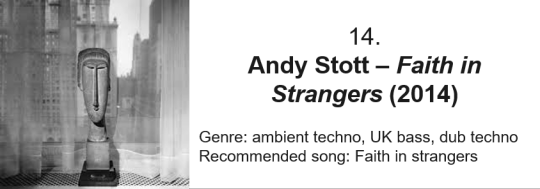
Andy Stott seems to delight in making his music as unnerving, haunting, perhaps even scary, as possible. The female vocals these songs are built around become ghostly, echoing and overlapping themselves disorientingly. The percussion, audibly resembling metal clanging, rustling or rattling in the distance, is often left to stand for its own, creating a tense space it feels like something should be filling. UK-based club and dub music can be felt influencing the grimy almost-but-not-quite danceable rhythms here, but the lo-fi recording and menacing vibe makes this feel like a rave at some sort of dimly lit abandoned factory.
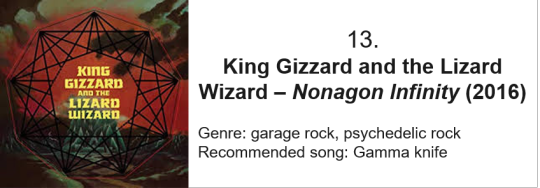
There’s so much Mad Max in this album you can just picture it being set to images of freights burning across the desert. True to its title, the nine songs on Nonagon Infinity roll into each other as if part of one big perpetual composition, with the end looping back seamlessly to the start and musical motifs cropping up both before and after the song they form the base of. With its fuzzy, raw sound, bluesy harmonica and wild whooping, the Gizz create a truly rollicking rock’n’roll experience. The band would go on to release 5 albums within twelve months a year later, but Nonagon shows these seven Australian madmen at the height of their powers.
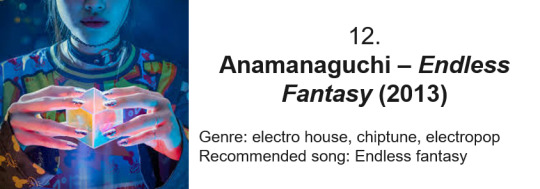
Sometimes you just want to listen to fun, hyperactive pop. The spirit of 8-bit video game soundtracks and snappy pop punk come together to create a vividly digital world of sound that seems to celebrate the worldliness, connectivity and shiny neon colours of early 2010s internet culture and social media. The up-pitched vocals and general auditory mania recall firmly Online musical trends like nightcore and vocaloid, while the beats pulse away, compelling you to dance like this is a house party and the best playlist ever assembled is on. It demands to be listened to at night with headphones, in a room lit only by your laptop screen.

“You hate everyone. To you everyone’s either a moron, or a creep or a poser. Why do you suddenly care about their opinion of you?” “Because I’m shallow, okay?! … I want them to like me.”
The fact that that Malcolm In The Middle quote is sampled at the emotional climax of this record should give some idea to the absurdity that defines Brave Little Abacus. It’s not even the only sample from the show on here. And yet the passion and urgency so evident in Adam Demirjian’s lispy singing and the band’s nostalgia-inducing, even cozy, melodies are made to stir feelings. The tearjerker chords and guitar progressions are so distinctive of emo bands with that special US-midwest melancholia, and they are interspersed with warm ambiance and playful sound effects ripped from TV and video games, seemingly vintage throwbacks to a sunny childhood. Demirjian’s lyrics, yelled out as if through tears or in the middle of a panic attack, verge on word salad in their abstraction, but that’s not the point: you can feel his small town loneliness and sense the trips he’s spent lost on memory lane. The combined effect all adds to Just Got Back’s themes of adolescence and the trauma of leaving it. While legendary in certain internet communities for this album and their 2009 masterpiece Masked Dancers, the band remains obscure to wider audiences.

These Danish punks know how to convey emotion through their raw and dramatic songs. Elias Rønnenfelt’s vocal presence and charisma cannot be ignored: his husky voice drawls, at times breaks, gasps for breath, builds up the deeply impassioned, intense force behind his words. The band sounds free and wild, unrestrained by a tight adherence to tempo, often speeding up, slowing down or straying from the vocals within the same song, as if playing live. Instrumentally the command over loud and quiet, tension and release, accentuates the vocals in crafting the album’s pace. Horns and saloon pianos throughout give the feel of a performance in a smoky, underground blues bar, with Rønnenfelt swaying onstage as he howls the romantic, distraught, heartbroken lyrics he truly believes in.
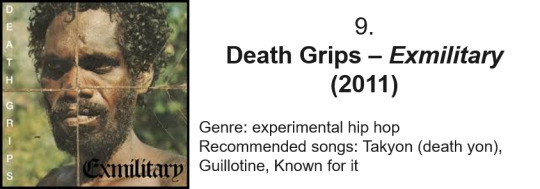
At some point on first listening to Death Grips, a thought along the lines of “He really yells like this the whole way through, huh?” probably crosses the mind. When Exmilitary first appeared, quietly uploaded to the internet, the rapper’s name and identity unknown, another likely reaction among listeners might have been “What am I even listening to?” But perhaps more revolutionary than Death Grips’ incredibly aggressive sound and style might have been its foreshadowing of how over the next decade underground rap acts would explode into the mainstream through viral songs, online word of mouth and memes. It showed all you needed to come from nowhere to the top of the game was to seize attention, and it did that and far more. MC Ride’s intoxicatingly crass, intense rapping captures the energy of a mosh pit where injuries happen, the barrage of sensations of a coke high, while the eclectic mix of rock and glitchy electronics on the instrumentals is disorienting in the best way. If rap were rock and this was 1977, Death Grips would have just invented punk. Ride’s lyrics paint a confrontational, hyper-macho persona; unlike much hip hop braggadocio, the overwhelming impression given is that Ride truly does not care what anyone thinks. He just goes hard and does not stop. It’s music to punch the wall to.
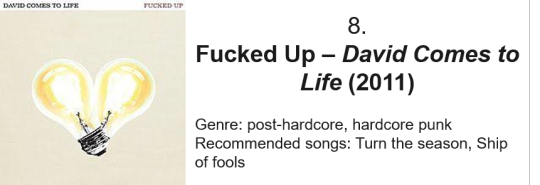
Inspired by classic rock operas, this concept album represents some major ambition and innovation in musical storytelling. Delivered in frontman Damian Abraham’s gravelly shouted vocals, the complex lyrical narrative of the album follows a factory worker, an activist and their struggle against the omnipotent author (Abraham himself) who controls their fates. Featuring devices like unreliable narrators and fourth-wall breaking, it takes some serious reading into to untangle. But it’s the bright guitarwork, combining upbeat punk rock and indie to create some killer riffs, that gives the album its furious energy and cinematic proportions.
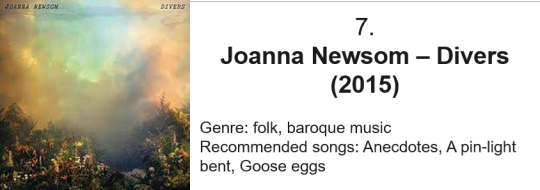
Joanna Newsom is enchanted by the past. Like 2006’s ambitious Ys, the music on Divers makes this evident with its invocation of Western classical and medieval music, throwing antiquated instruments like clavichords together with lush string orchestration, woodwinds, organs, folk guitar and Newsom’s signature harp. With her soulful, moving vocals leading the way, it’s hard not to imagine her as some kind of Renaissance-era country woman contemplating nature, love and mortality in the fields and the woods. As always Newsom proves herself a stunningly original and creative arranger with the sheer compositional intricacy and flow of these songs, and most of all the harmonious intertwining of singing and instrumental backing.

Burial’s music is born from the London night: the bustle of the streets, the faint sounds from distant raves, the buskers, the rain on bus windows. This EP’s dreamlike quality makes listening to it feel like taking a trip across the city well after midnight, watching the lights go by, with no idea where you hope to get to. Every single sound and effect on these two songs is so precisely chosen, from the shifting and shuffling beats, the swelling synths and wordless vocals that sound like a club from a different dimension, the ambient hiss and pop of a vinyl record. Musically this sound is drawn from UK-based scenes like 2-step and drum ‘n bass, but twisted into such a moody and abstracted form as to be nearly unrecognisable as dubstep. Just when this urban, dismal sound is at its most oppressive, heavenly soul singers or organs cut through like a ray of light in the dark.
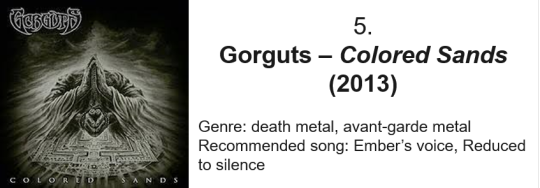
There’s an imaginary rulebook of how construct music, how to properly make tempos and combinations of notes sound harmonious, and Gorguts have spent their career ripping it up and throwing it in the bin. On 1998’s seminal Obscura, their atonal experimentation sounded at times like random noises in random order. But listen closely to Obscura or Colored Sands, their return after a long hiatus, and the method behind the madness emerges. One mark of great death metal is that it’s impossible to predict what direction it will go even a few seconds in advance, and the band achieves this while presenting a heavy, slow, momentous sound. The density of inspired riffs, and the intricate balancing of loud and quiet, fast and slow paced throughout these songs are exceptional. In instrumental sections the guitars will echo out as if across a barren plane, then the song will build up to the momentum of a freight train. Behind the crashing and twisting walls of guitar the patterns of blast beat drumming are almost mathematical in nature. Luc Lemay’s harsh bellows sound like a warlord’s cry or a pure expression of rage to the void. It’s threatening, menacing, unapproachable, but it all makes sense in the end.
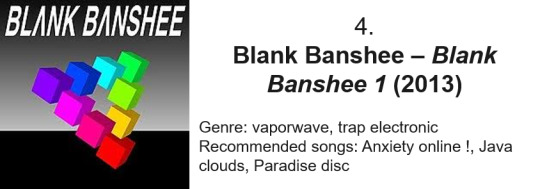
Futuristic yet deeply retro, Blank Banshee’s music takes vaporwave beyond its roots in the pure consumerist parody of artists like Vektroid and James Ferraro and makes it actually sound amazing. Songs are built out of a single vocal snippet processed beyond recognition, new agey synthesisers, Windows XP-era computer noises, hilariously out of place instruments, all set to the 808 bass and hi-hats of hip-hop style beats. The genre’s pioneers intentionally sucked the soul from their music using samples pulled from 70s and 80s elevators, infomercials and corporate lounges - here the throwback seems to be to the early 2000s childhood of the internet, and the influence of a time when email and forums were revolutionary can be felt. The effect of this insanity is an album that whirls by like a techno-psychedelic haze: the atmosphere of dark trap beats places you squarely in a 2013 studio one moment, the next you’re surrounded by relaxing midi pianos and humming that a temple of new age practitioners would meditate to. Still, at some point when listening to this album, perhaps when the ridiculous steel drums kick in near the end, you realise that this is all to some degree a joke, and a funny one. It’s hard to overstate what an entertaining half-hour this thing is.

While 2012’s Good Kid, m.a.a.d City presented a movie in album form of Kendrick’s childhood and early adult years, TPAB’s journey is one of personal growth, introspection, and nuanced examination of the state of race in post-Ferguson America. It’s simultaneously the Zeitgeist for the US in 2015 and a soul-search in the therapist’s office. Sounding deeply vulnerable, he openly discusses depression, alcoholism, religion and feelings of helplessness. The White House and associated gangstas on the cover give some idea to the album’s political themes, with Lamar contrasting Obama’s presidency to the political powerlessness and lifelong ghetto entrapment of millions of black Americans. Everything I’ve written about the lyrics here really only scratches the surface because the words here are substantive, complex and dense with meaning. Near enough every bar can be analysed for multiple meanings and interpretations, essays can and have been written on the overall work, anything less does not do justice. The musical versatility on display is astounding: the album acts as an extravaganza of African-American music, from smooth west coast G-funk to east coast grit, neo-soul and rock to beat poetry, and most of all jazz. Like an expertly laid character arc the record progresses through its ideas in such a way that they’re all impactful, with the slurred rapping imitating a depressed drunken stupor followed later by exuberant, defiant cries of “I love myself!”, the white-hot rage against police brutality balanced by the hopeful mantra: “do you hear me, do you feel me, we gon be alright”. Perhaps the most culturally significant album of the 2010s and an essential piece of the hip-hop canon.
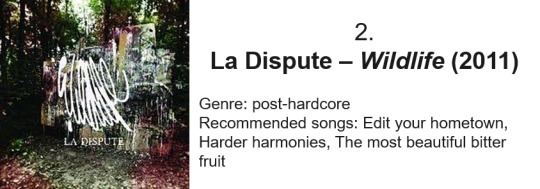
This harrowing hour chronicles the struggles and everyday tragedy of a series of characters and their relationship with the city they live in, narratively driven by some outstandingly poetic lyrics. Jordan Dreyer’s wordy tales despair at the poverty, gang violence and urban decay in the band’s native Grand Rapids, Michigan, an almost childlike open-hearted naivete in his words as he empathises with the broken and alienated people in these songs. There’s no jaded sneer or sly lesson to be learned as he sings about the child killed by a stray bullet or the homebird left alone after all their friends move away, just genuine second-hand sadness and a dream that compassion and community will eventually heal the pain. Taking elements from bands like At the Drive-In’s fusion of punk and progressive, and mewithoutyou’s shout-sung vocals, La Dispute hones its sound to a razor edge to put fierce instrumental power behind the lyrics. Not an easy listen, but a sharply written songbook and a perfect execution on its concept.

Around 2008, Joanna Newsom met comedian Andy Samberg. Within a year, their relationship was becoming the basis upon which the poetry of Have One on Me was spun. Newsom’s lyrics, exploring her relationship with her future-husband, nature, death, spirituality, are above all else loving. Through her warm and vibrant voice, at times an operatic trill and in others deeply soulful, she expresses the joy of love for another, the peace and earthly connection of her beloved pastoral lifestyle, deeply affecting melancholy and grief. Contemplative, artful, genuine or expressive: every lyric in every sweet melody is used to offer her ruminations on life or overflowings of passion.
More so than her previous and next albums, the feel of the album is of not just a folkloric past but also the present day, with drums, substantial brass and string arrangements, and even electric guitar anchoring the sound to Newsom’s real, not imaginary, life in the 21st century. Yet songs here with moods or settings evoking simpler lifestyles and the women living them in 1800s California or the Brontës’ English moors still have a universal relevance. Whether rooted in past of present, the instrumental variety of these compositions, from classical solo piano, grand orchestral arrangements led by harp, to the twang of country guitars or intricate vocal harmonising, makes it apparent that this is the work of a master songwriter in full command of well over a dozen talented musicians. Ultimately, what makes this my favourite album of the decade is that, very simply, it is one stunningly beautiful song after another, all collated into a cohesive 2-hour portrait of Newsom’s soul.
4 notes
·
View notes